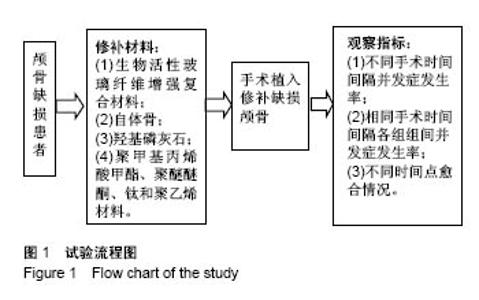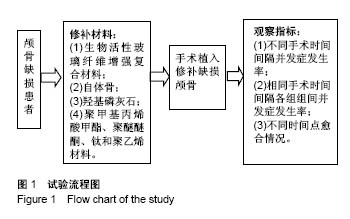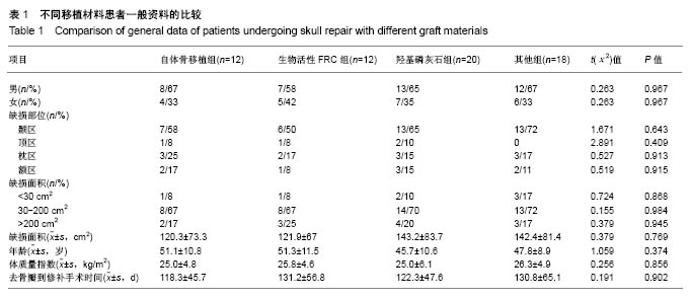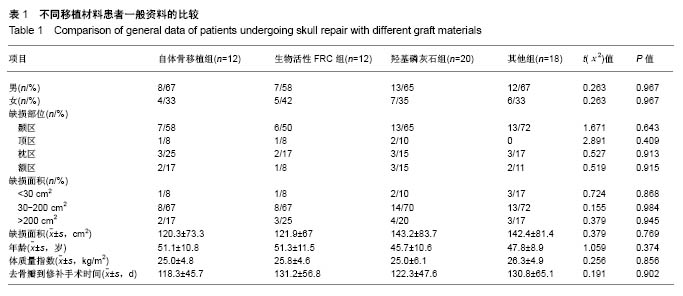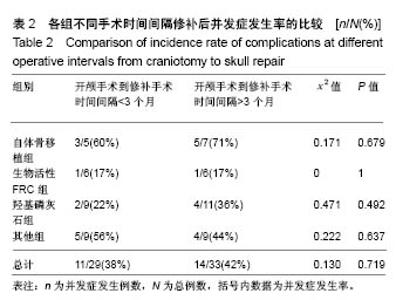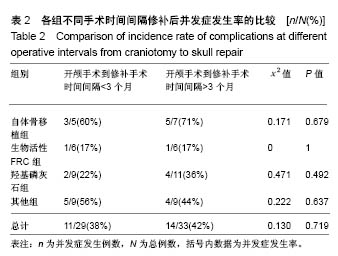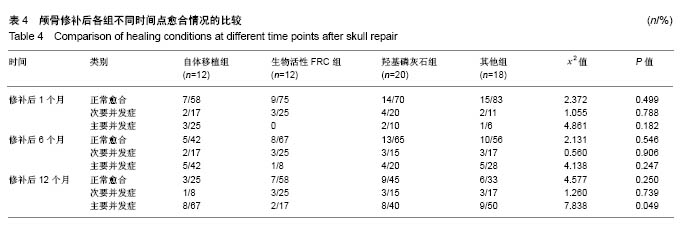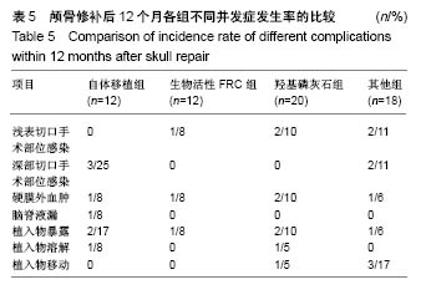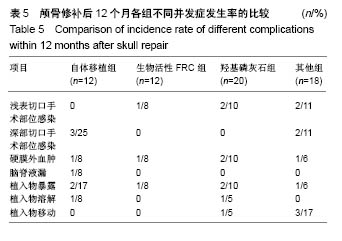Chinese Journal of Tissue Engineering Research ›› 2018, Vol. 22 ›› Issue (30): 4794-4799.doi: 10.3969/j.issn.2095-4344.0970
Previous Articles Next Articles
Complications of skull repair with autologous and artificial bone grafts
Li Jian-ping1, Yang Lin1, Qin Yi2, Jiang Zhen-dong1, Lu Wei1
- 1Department of Human Anatomy, Zunyi Medical College Zhuhai Campus, Zhuhai 519041, Guangdong Province, China; 2Department of Orthopedics, Zhuhai People’s Hospital, Zhuhai 519000, Guangdong Province, China
-
Received:2018-05-02Online:2018-10-28Published:2018-10-28 -
Contact:Lu Wei, Master, Associate professor, Department of Human Anatomy, Zunyi Medical College Zhuhai Campus, Zhuhai 519041, Guangdong Province, China -
About author:Li Jian-ping, Master, Lecturer, Department of Human Anatomy, Zunyi Medical College Zhuhai Campus, Zhuhai 519041, Guangdong Province, China -
Supported by:the National Natural Science Foundation of China, No. 81760416; the Scientific Research Project of Zunyi Municipality, No. E-199
CLC Number:
Cite this article
Li Jian-ping, Yang Lin, Qin Yi, Jiang Zhen-dong, Lu Wei. Complications of skull repair with autologous and artificial bone grafts[J]. Chinese Journal of Tissue Engineering Research, 2018, 22(30): 4794-4799.
share this article
| [1] Honeybul S,Ho KM.How “successful” is calvarial reconstruction using frozen autologous bone.Plast Reconstr Surg.2012;130(5):1110-1117.[2] Joseph V,Reilly P.Syndrome of the trephined.J Neurosurg. 2009;111:650-652.[3] Lee CH,Chung YS,Lee SH,et al.Analysis of the factors influencing bone graft infection after cranioplasty.J Trauma Acute Care Surg.2012;73(1):255-260.[4] Neovius E,Engstrand T.Craniofacial reconstruction with bone and biomaterials: review over the last 11 years.J Plast Reconstr Aesthet Surg.2010;63(10):1615-1623.[5] Wachter D,Reineke K,Behm T,et al.Cranioplasty after decompressive hemicraniectomy: underestimated surgery-associated complications? Clin Neurol Neurosurg. 2013;115(8):1293-1297.[6] Bobinski L,Koskinen LO,Lindvall P.Complications following cranioplasty using autologous bone or polymethylmethacrylate—retrospective experience from a single center.J Craniofac Surg.2013;18(24):1606-1609.[7] Chang V,Hartzfeld P,Langlois M,et al.Outcomes of cranial repair after craniectomy.J Neurosurg.2010;112(5):1120-1124.[8] Lin AY,Kinsella CR Jr,Rottgers SA,et al.Custom porous polyethylene implants for large-scale pediatric skull reconstruction:early outcomes.J Craniofac Surg. 2012;23(5): 67-70.[9] 郝强,赵丽,关继奎,等.人工骨材料在骨缺损修复中的应用[J].中国组织工程研究与临床康复,2009,13(34):6745-6748.[10] 郝剑,郝钊.骨移植材料研究进展[J].中国中西医结合外科杂志, 2016,22(1):92-94.[11] 归来,左锋,张智勇,等.颅骨缺损的个性化修复[J].中华整形外科杂志,2004,20(2):98-100.[12] Wheeler DL,Stokes KE,Hoellrich RG,et al.Effect of bioactive glass particle size on osseous regeneration of cancellous defects.J Biomed Mater Res.1998;41(4):527-533.[13] Aitasalo KM,Piitulainen JM,Rekola J,et al.Craniofacial bone reconstruction with bioactive fiber-reinforced composite implant.Head Neck.2014;36(5):722-728.[14] Piedra MP,Thompson EM,Selden NR,et al.Optimal timing of autologous cranioplasty after decompressive craniectomy in children.J Neurosurg Pediatr.2012;9(10):268-272.[15] Sundseth J,Sundseth A,Berg-Johnsen J,et al.Cranioplasty with autologous cryopreserved bone after decompressive craniectomy: complications and risk factors for developing surgical site infection. Acta Neurochir (Wien). 2014;156(4): 805-811.[16] Chen Y,Yan Y,Li X,et al.Application of ultrasound on monitoring the evolution of the collagen fiber reinforced nHAC/CS composites in vivo.Biomed Res Int. 2014;35(2): 4183-4192.[17] Gao T,Aro HT,Ylänen H,et al.Silica-based bioactive glasses modulate expression of bone morphogenetic protein-2mRNA in Saos-2 osteoblasts in vitro.Biomater. 2001;22(12): 1475-1483.[18] Knabe C,Stiller M,Berger G,et al.The effect of bioactive glass ceramics on the expression of bone-related genes and proteins in vitro.Clin Oral Implants Res.2005;16(1):119-127.[19] 吴锦春,孙俊英,王禹基,等.生物活性玻璃颗粒治疗股骨干骨折的疗效评价[J].苏州大学学报:医学版,2005,25(2):298-299.[20] Xu W,Ma J,Jabbari E.Material properties and osteogenic differentiation of marrow stromal cells on fiber-reinforced laminated hydrogel nanocomposites.Acta Biomater. 2010; 6(6):1992-2002.[21] Ballo AM,Cekic-Nagas I,Ergun G,et al.Osseointegration of fiber-reinforced composite implants: histological and ultrastructural observations.Dent Mater.2014;30(12):384-395.[22] Posti JP,Piitulainen JM,Hupa L,et al.A glass fiber-reinforced composite - bioactive glass cranioplasty implant: A case study of an early development stage implant removed due to a late infection.J Mech Behav Biomed Mater.2015;55(14):191-200.[23] Guarino V,Ambrosio L.The synergic effect of polylactide fiber and calcium phosphate particle reinforcement in poly epsilon-caprolactone-based composite scaffolds.Acta Biomater.2008;6(4): 1778-1787.[24] Vallittu PK.Effect of 10 years of in vitro aging on the flexural properties of fiber-reinforced resin composites.Int J Prosthodont. 2007;20(1):43-45.[25] Piitulainen JM,Kauko T,Aitasalo KM,et al.Outcomes of cranioplasty with synthetic materials and autologous bone grafts.World Neurosurg.2015;83(5):708-714.[26] Petersen RC.Titanium Implant Osseointegration Problems with Alternate Solutions Using Epoxy/Carbon-Fiber- Reinforced Composite.Metals (Basel).2014;4(4):549-569.[27] Llapur CJ,Martinez MR,Caram MM,et al.Increased lung volume in infants and toddlers at high compared to low altitude.Pediatr Pulmonol.2013;12(48):1224-1230.[28] Ueki K,Ishihara Y,Yoshizawa K,et al.Evaluation of bone formation after sagittal split ramus osteotomy using different fixation materials.J Craniomaxillofac Surg. 2015;43(5): 710-716. [29] Chou JI,Fong HJ,Kuang SH.A retrospective analysis of the stability and relapse of soft and hard tissue change after bilateral sagittal split osteotomy for mandibular setback of 64 Taiwanese patients.J Oral Maxillofac Surg. 2005;21(63): 355-361.[30] Ueki K,Okabe K,Miyazaki M,et al.Skeletal stability after mandibular setback surgery: comparisons among unsintered hydroxyapatite/poly-L-lactic acid plate, poly-L-lactic acid plate, and titanium plate.J Oral Maxillofac Surg. 2011;8(69): 1464-1468.[31] Yadla S,Campbell PG,Chitale R,et al.Effect of early surgery, material, and method of flap preservation on cranioplasty infections: a systematic review.Neurosurgery. 2011;25(68): 1124-1129. |
| [1] | Zhang Tongtong, Wang Zhonghua, Wen Jie, Song Yuxin, Liu Lin. Application of three-dimensional printing model in surgical resection and reconstruction of cervical tumor [J]. Chinese Journal of Tissue Engineering Research, 2021, 25(9): 1335-1339. |
| [2] | Zeng Yanhua, Hao Yanlei. In vitro culture and purification of Schwann cells: a systematic review [J]. Chinese Journal of Tissue Engineering Research, 2021, 25(7): 1135-1141. |
| [3] | Xu Dongzi, Zhang Ting, Ouyang Zhaolian. The global competitive situation of cardiac tissue engineering based on patent analysis [J]. Chinese Journal of Tissue Engineering Research, 2021, 25(5): 807-812. |
| [4] | Wu Zijian, Hu Zhaoduan, Xie Youqiong, Wang Feng, Li Jia, Li Bocun, Cai Guowei, Peng Rui. Three-dimensional printing technology and bone tissue engineering research: literature metrology and visual analysis of research hotspots [J]. Chinese Journal of Tissue Engineering Research, 2021, 25(4): 564-569. |
| [5] | Chang Wenliao, Zhao Jie, Sun Xiaoliang, Wang Kun, Wu Guofeng, Zhou Jian, Li Shuxiang, Sun Han. Material selection, theoretical design and biomimetic function of artificial periosteum [J]. Chinese Journal of Tissue Engineering Research, 2021, 25(4): 600-606. |
| [6] | Liu Fei, Cui Yutao, Liu He. Advantages and problems of local antibiotic delivery system in the treatment of osteomyelitis [J]. Chinese Journal of Tissue Engineering Research, 2021, 25(4): 614-620. |
| [7] | Li Xiaozhuang, Duan Hao, Wang Weizhou, Tang Zhihong, Wang Yanghao, He Fei. Application of bone tissue engineering materials in the treatment of bone defect diseases in vivo [J]. Chinese Journal of Tissue Engineering Research, 2021, 25(4): 626-631. |
| [8] | Zhang Zhenkun, Li Zhe, Li Ya, Wang Yingying, Wang Yaping, Zhou Xinkui, Ma Shanshan, Guan Fangxia. Application of alginate based hydrogels/dressings in wound healing: sustained, dynamic and sequential release [J]. Chinese Journal of Tissue Engineering Research, 2021, 25(4): 638-643. |
| [9] | Chen Jiana, Qiu Yanling, Nie Minhai, Liu Xuqian. Tissue engineering scaffolds in repairing oral and maxillofacial soft tissue defects [J]. Chinese Journal of Tissue Engineering Research, 2021, 25(4): 644-650. |
| [10] | Xing Hao, Zhang Yonghong, Wang Dong. Advantages and disadvantages of repairing large-segment bone defect [J]. Chinese Journal of Tissue Engineering Research, 2021, 25(3): 426-430. |
| [11] | Zeng Xianghong, Liang Bowei. A new strategy for the treatment of osteonecrosis of the femoral head [J]. Chinese Journal of Tissue Engineering Research, 2021, 25(3): 431-437. |
| [12] | Chen Siqi, Xian Debin, Xu Rongsheng, Qin Zhongjie, Zhang Lei, Xia Delin. Effects of bone marrow mesenchymal stem cells and human umbilical vein endothelial cells combined with hydroxyapatite-tricalcium phosphate scaffolds on early angiogenesis in skull defect repair in rats [J]. Chinese Journal of Tissue Engineering Research, 2021, 25(22): 3458-3465. |
| [13] | Wang Hao, Chen Mingxue, Li Junkang, Luo Xujiang, Peng Liqing, Li Huo, Huang Bo, Tian Guangzhao, Liu Shuyun, Sui Xiang, Huang Jingxiang, Guo Quanyi, Lu Xiaobo. Decellularized porcine skin matrix for tissue-engineered meniscus scaffold [J]. Chinese Journal of Tissue Engineering Research, 2021, 25(22): 3473-3478. |
| [14] | Mo Jianling, He Shaoru, Feng Bowen, Jian Minqiao, Zhang Xiaohui, Liu Caisheng, Liang Yijing, Liu Yumei, Chen Liang, Zhou Haiyu, Liu Yanhui. Forming prevascularized cell sheets and the expression of angiogenesis-related factors [J]. Chinese Journal of Tissue Engineering Research, 2021, 25(22): 3479-3486. |
| [15] | Liu Chang, Li Datong, Liu Yuan, Kong Lingbo, Guo Rui, Yang Lixue, Hao Dingjun, He Baorong. Poor efficacy after vertebral augmentation surgery of acute symptomatic thoracolumbar osteoporotic compression fracture: relationship with bone cement, bone mineral density, and adjacent fractures [J]. Chinese Journal of Tissue Engineering Research, 2021, 25(22): 3510-3516. |
| Viewed | ||||||
|
Full text |
|
|||||
|
Abstract |
|
|||||
